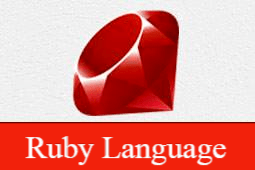
- Index
- Ruby tutorial
- Introduction to Ruby
- Ruby - Environment Setup
- Ruby Installation - Unix
- Ruby Installation In Windows
- Ruby - Command Line Options
- Ruby - Environment Variables
- Ruby - Syntax
- Ruby - Classes and Objects
- Ruby case
- Ruby - Variables, Constants and Literals
- Ruby - Operators
- Ruby - Comments
- Ruby - if...else
- Ruby - Loops
- Ruby - Methods
- Ruby - Blocks
- Ruby - Modules and Mixins
- Ruby - Strings
- Ruby - Arrays
- Ruby - Hashes
- Ruby - Date & Time
- Ruby - Ranges
- Ruby - Iterators
- Ruby - File I/O
Ruby - Blocks
Ruby - Blocks
You have seen how Ruby defines methods where you can put number of statements and then you call that method. Similarly, Ruby has a concept of Block.
-
A block consists of chunks of code.
-
You assign a name to a block.
-
The code in the block is always enclosed within braces ({}).
-
A block is always invoked from a function with the same name as that of the block. This means that if you have a block with the name test, then you use the function test to invoke this block.
-
You invoke a block by using the yield statement.
Syntax
block_name {
statement1
statement2
..........
}
|
Here, you will learn to invoke a block by using a simple yield statement. You will also learn to use a yield statement with parameters for invoking a block. You will check the sample code with both types of yield statements.
The yield Statement
Let's look at an example of the yield statement
#!/usr/bin/ruby
def test
puts "You are in the method"
yield
puts "You are again back to the method"
yield
end
test {puts "You are in the block"}
|
Output:
You are in the method
You are in the block
You are again back to the method
You are in the block
|
You also can pass parameters with the yield statement
#!/usr/bin/ruby
def test
yield 5
puts "You are in the method test"
yield 100
end
test {|i| puts "You are in the block #{i}"}
|
Output
You are in the block 5
You are in the method test
You are in the block 100
|
Here, the yield statement is written followed by parameters. You can even pass more than one parameter. In the block, you place a variable between two vertical lines (||) to accept the parameters. Therefore, in the preceding code, the yield 5 statement passes the value 5 as a parameter to the test block.
Now, look at the following statement
test {|i| puts "You are in the block #{i}"}
|
Here, the value 5 is received in the variable i. Now, observe the following puts statement
puts "You are in the block #{i}"
|
The output of this puts statement is
You are in the block 5
|
If you want to pass more than one parameters, then the yield statement becomes
yield a, b
|
and the block is
test {|a, b| statement}
|
Blocks and Methods
You have seen how a block and a method can be associated with each other. You normally invoke a block by using the yield statement from a method that has the same name as that of the block. Therefore
#!/usr/bin/ruby
def test
yield
end
test{ puts "Hello world"}
|
This example is the simplest way to implement a block. You call the test block by using the yield statement.
But if the last argument of a method is preceded by &, then you can pass a block to this method and this block will be assigned to the last parameter. In case both * and & are present in the argument list, & should come later
#!/usr/bin/ruby
def test(&block)
block.call
end
test { puts "Hello World!"}
|
Output
Hello World!
BEGIN and END Blocks
Every Ruby source file can declare blocks of code to be run as the file is being loaded (the BEGIN blocks) and after the program has finished executing (the END blocks)
#!/usr/bin/ruby
BEGIN {
# BEGIN block code
puts "BEGIN code block"
}
END {
# END block code
puts "END code block"
}
# MAIN block code
puts "MAIN code block"
|
A program may include multiple BEGIN and END blocks. BEGIN blocks are executed in the order they are encountered. END blocks are executed in reverse order
Output
BEGIN code block
MAIN code block
END code block
|
Subscribe For Daily Updates
-
Ruby program to add two integer numbers
-
how to create an array with Array.[](*args) in Ruby ?
-
What are the various Ruby runtimes, and how are they different?
-
Ruby program to check whether the given number is prime or not
-
Ruby program to reverse a string
-
Ruby program to check whether the given number is palindrome
-
Ruby program to print Fibonacci series
-
How to Replace array elements in Ruby?
-
Ruby program to print an array
-
Ruby program to check whether the given number is Armstrong
- What is the difference between a lambda, a block and a proc?
-
Program to Print Triangle of Numbers in Ruby
-
How to add/remove elements to Array in Ruby?
-
How to shuffle an array in Ruby?
-
Creating Array with Array.new(size, obj) in Ruby
-
Ruby program to generate random numbers
-
Ruby program to Calculate the factorial of given number
-
What are #method_missing and #send? Why are they useful?
-
How to Sort Array in Ruby?
-
How to get index of array element in Ruby
- What are some of your favorite gems? What are their alternatives?
-
How to Get Input with Gets in Ruby
-
How to create two dimensional array in ruby?